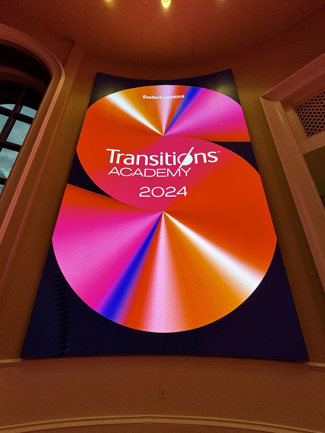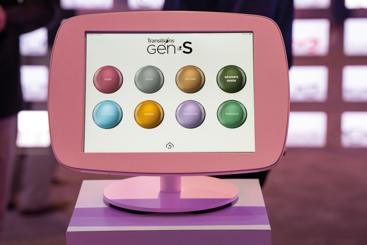
Chrystel Barranger, president EMEA wholesale and global president Transitions Optical, welcomes more than 1,300 to the 2023 Academy
There cannot be many better opportunities to launch a ground-breaking photochromic ophthalmic lens than a three-day education event devoted to all things Transitions. But with 1,300 of the company’s strongest supporters in attendance at the JW Marriott Grande Lakes in Orlando, Transitions would need something special up its sleeve.
Luckily, the product Transitions had ready to go was Gen S, the result of more than five years of research and development. On a vast stage with three giant screens, Transitions Optical global vice president for innovation, technology and operations Dr Brian O’Neill, told the crowd Gen S was the result of a ‘no compromise’ attitude towards development, with 450 prototype lenses created by a team of more than 150 scientists that began work on the project in 2018.
 ‘This isn’t anything you’ve seen so far. It isn’t even an incremental update in technology. It’s a fundamental shift in how we even think about what some may refer to as a lens,’ said O’Neill in his opening address. ‘It may look like a lens, but it’s actually the most complex yet balanced light management system we at Transitions have ever built,’ he adds.
‘This isn’t anything you’ve seen so far. It isn’t even an incremental update in technology. It’s a fundamental shift in how we even think about what some may refer to as a lens,’ said O’Neill in his opening address. ‘It may look like a lens, but it’s actually the most complex yet balanced light management system we at Transitions have ever built,’ he adds.
Alongside O’Neill on stage was Jérôme Butez, vice president of global marketing and chief marketing officer for Transitions Optical at EssilorLuxottica. ‘The innovation journey of Gen S began with one vision in mind to wow all eyeglasses wearers,’ says Butez. ‘So, what did we do? Well, first we listened to their needs, not only in terms of vision care, but also light management and lifestyle.
‘Guess what? People want it all. They want vision. They want protection. They want the speed; they want darkness, but with beautiful colours at all times. And they want a seamless experience, effortless and fluid between indoor, outdoor and all the situations in between.
‘So far, we (lens manufacturers) have all had to make some sort of trade-off, and we did not want to compromise. We have been relentless in our quest to deliver the perfect intelligent light management system.’
Gen S at a glance
The new lens combines three core elements of performance to deliver Gen Speed, Gen Style and Gen Smart. During the launch, Transitions said speed was represented by being the fastest dark lens in the clear to dark photochromic category – activating outdoors in just two seconds, reaching category three darkness in 25 seconds, and fading back to fully clear in less than two minutes.

Gen Style is taken care of by eight colours, including a new ruby tint. The existing hues of brown, graphite green, grey, sapphire, amethyst, amber and emerald all redeveloped pigments optimised to be true to tone at all stages of activation, which Transitions said would appeal to a younger demographic of wearer.
The Gen Smart element covers visual performance for the modern-day wearer. Research conducted for Transitions found 39% of wearers had faster vision recovery from intense bright lights versus clear lenses, with fade back tests 39.5% improvement in contrast sensitivity and 40% faster vision recovery versus the previous iteration, Gen 8.
Beyond 6/6
To assess the performance scope of Gen S, Transitions partnered with Billy Hammond, professor in behavioural and brain science within the Vision Sciences Laboratory at the University of Georgia to run a clinical trial. Prof Hammond told delegates he believed many optometrists thought of vision as a simple refraction, but in the real world, vision was far more complex, with fast-moving chromatic content.
‘Take baseball as an example,’ he said. ‘A pitcher now can throw a fastball about 90 to 100mph, but they only throw it 67ft. That means that the ball crosses the batter plate in about 200, 300 milliseconds. Given that it takes 502 milliseconds to consciously see something, the batter must hit the ball without seeing it. So, things move very fast.’
The University of Georgia’s clinical trial simulated ecological vision conditions using 1,000-watt xenon light source that replicated sunlight. The 36 healthy adult participants were tested with either a clear lens or a fully activated Transitions Gen S lens to see how each lens affected their response to the light source.
‘We found that when you use these bright light flashes, it disables vision for a little while by bleaching photopigment, that bounds the retina to an opposite,’ said Prof Hammond. ‘It takes a while for them to rejoin and for visual sensitivity to return. That’s photo stress.’
The subjects wearing the Gen S lenses saw their recovery and ability to see contrast gradings sped up by approximately 40%, which Hammond said equated to six seconds in real world terms.
Emphasising the point, Hammond said: ‘Six seconds isn’t all that much time, but it’s a huge amount of time to see that much sooner. If you’re driving your car 60mph and you see six seconds sooner, that’s about 200 yards of distance.’
Glare discomfort was also measured in the trial. ‘There’s two ways to measure this, said Prof Hammond. ‘Subjectively, that you can use that sort of numerical scale and ask people how bothersome they found the light. You can also measure it objectively. One way to do it is to measure the activation of their squint.
'We used a high-resolution camera with biometric software and then measured the height of their palpable fissure before being exposed to light stress and then during light stress to see how much their squint changed. What we found is that when they used the Transitions Gen S lens, it reduced their squinting by about 50%.’
New wearers
Improving market penetration has long been a primary goal for Transitions. During the event, several different statistics were cited by Transitions speakers. Globally, one in 10 pairs of frames are dispensed with Transitions, increasing to two in 10 pairs in North America.
Tellingly, that figure doubles to four in every 10 pairs of glasses with progressive lenses in North America, highlighting the age demographic that’s most loyal to Transitions and photochromic lenses in general.
With Gen S, Transitions hope to change that, through the new range of improved colours and aggressive marketing campaigns with influencers and social media platforms such as TikTok. Wearer research on the Gen S lens indicated that the lens may well find popularity among a new demographic.
For example, 88% of younger wearers found the lens fitted their lifestyles, and 86% liked the look of the lens during mid-tint activation, something that the company said had been improved significantly with redeveloped dyes. Positively, 76% of wearers said Gen S had changed their perspective of photochromic lenses.
My Transitions Academy: Nichola Mason, director, Appleman Charman Opticians
 'I felt very honoured to attend the Transitions Academy at such an exciting time. It was a great opportunity to brush up on my Transitions knowledge and learn all about the new Gen S lenses, which I am eager to offer to my customers.
'I felt very honoured to attend the Transitions Academy at such an exciting time. It was a great opportunity to brush up on my Transitions knowledge and learn all about the new Gen S lenses, which I am eager to offer to my customers.
'The presentations from the Transitions team were educational and shared insights into the process of developing new technology – something we readily take for granted.
'The breakout workshops were engaging and thought provoking – it is always good to have your own thinking challenged and pick up tips to improve the practice customer journey.
'I met fellow professionals from across Europe and North America, which added to the experience. My take home to my teams has been there is so much more to Transitions than grey/brown single pairs. Let’s embrace colour, choice and multiple pairs.'
- An article on styling photochromic lenses will appear in a future issue of Optician.


